Shrimp and Grit: Fighting to save the Fort Myers Beach shrimping fleet after Ian's devastation
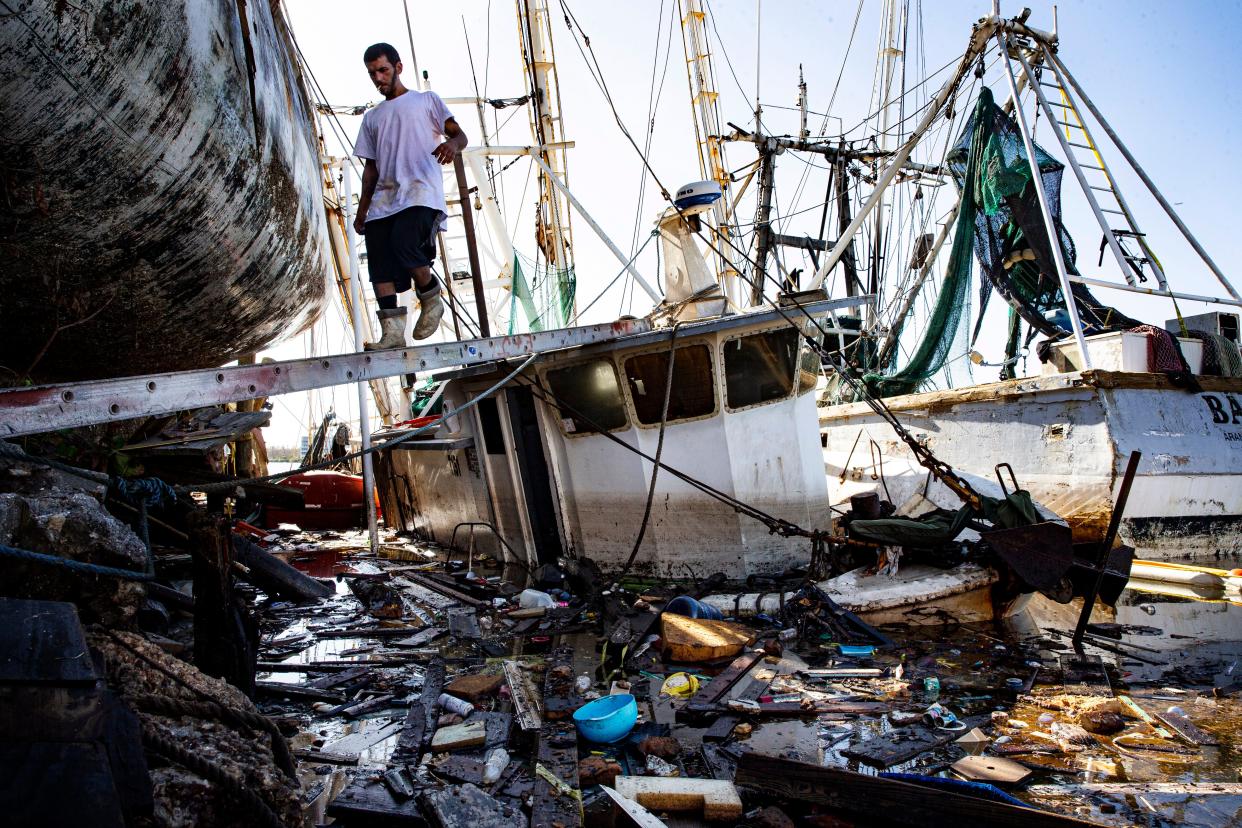
A crowd of captains and crew gathered near the battered shrimp docks of Fort Myers Beach. In the water sat their only real hope, a barge with a 160-foot crane.
If this crane could plant itself firmly enough in Matanzas Pass, if it could reach far enough without rolling, if it could hoist hard enough, it would haul a 200-ton steel shrimping boat from shore and ease it back into the water. Just one boat, but one twice the weight of a commercial plane. But if this crane could do all that, maybe their fleet − their industry, their traditions, their way of life − could be saved.
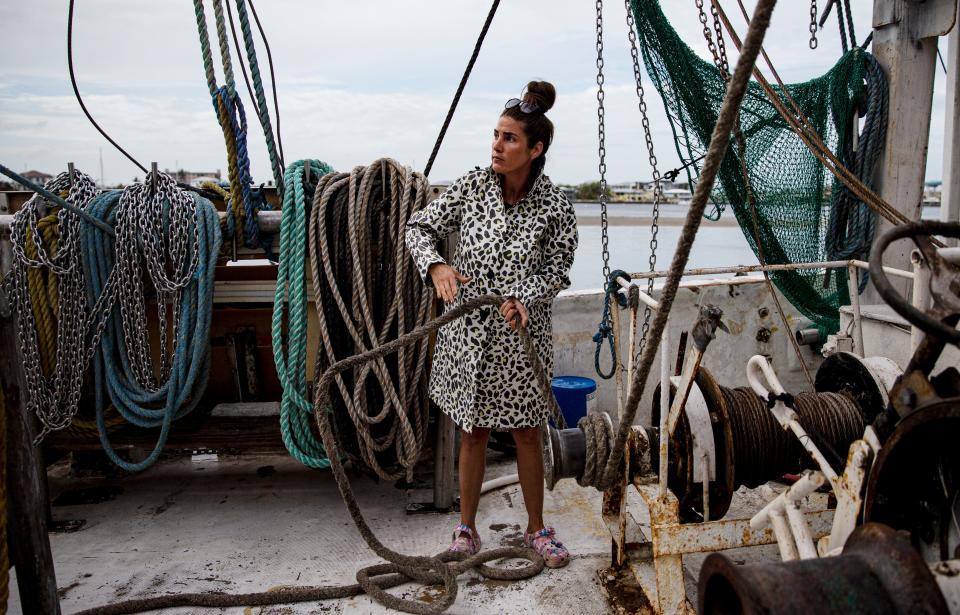
Anna Erickson, in Crocs and a cap, circulated among shrimpers in sturdy sneakers and shorts, offering smiles. At 36, Anna was poised to take over the Erickson & Jensen Shrimp Packers, from her father. She was the future of the shrimping industry in Fort Myers Beach − if it had one at this point. It was early November, more than a month after Hurricane Ian’s surge had shoved its way ashore and grounded all but a few of the 40 boats in the shrimping fleet.
The Perseverance sunk. The Penny V was crushed. The Pleiades cracked in half. Aces & Eights had five holes. The Babe took a beating. The Capt. Ryan was boxed in. The Kayden Nicole tipped. Boats were scattered along the San Carlos Island waterfront in clusters. Six boats were flung into bushes, sea grape trees and dead mangroves not far from Trico Shrimp Company, the other major shrimp player on the waterfront. Ten floated maybe a quarter mile west, up into an RV park and a boatyard.
Most of these boats were old before Ian arrived. They had been built to last one decade but stretched for five, held together with the glue of ingenuity, by owners and mechanics unwilling to concede to those who called it a dying industry.
Right after Ian, just one boat was fit for sea. It was the Malolo, the namesake of the boat Anna’s great-grandfather had first brought to Fort Myers.
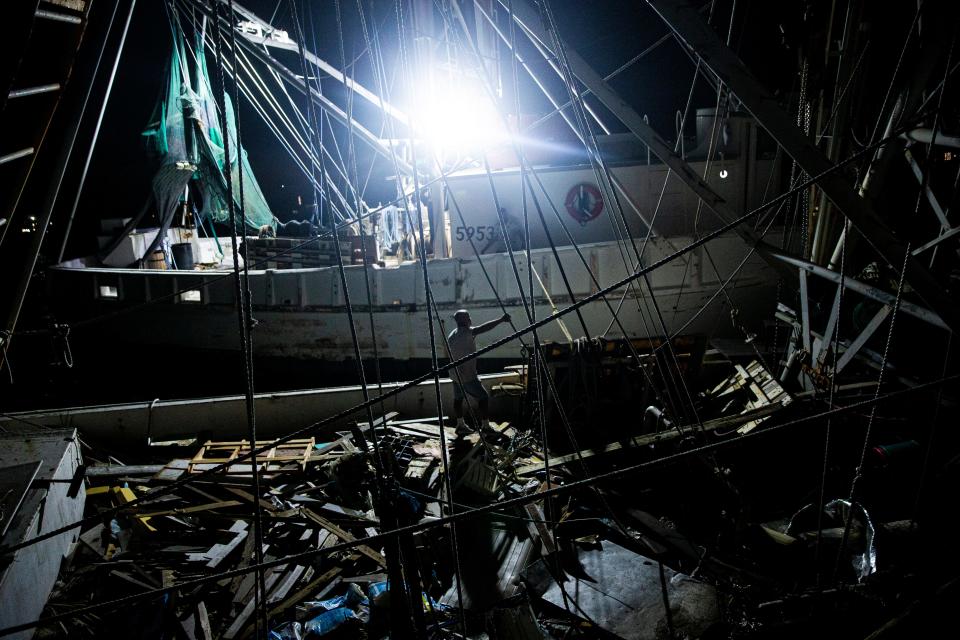
The crane towered over another Erickson boat, the Double E, which was perched on concrete near the welding shop. Men in hard hats barked commands and cursed under the tension. They hooked the boat from the stern and pulled. Metal clanked and creaked as the boat shifted. The crane dragged the Double E into the water.
The crowd cheered. “Whoa! There she goes! She’s in the water!”
Anna rushed in for a closer look. She knew the Double E wasn’t in any sort of shape to go shrimping. As for the rest of the fleet, it was all up in the air.
With no fleet there would probably be no more real industry here. Four generations of history would be over, and the landings that helped build this town − a haul so rich they called it "pink gold" − would wane to almost nothing.
In the months since Ian, captains, crew members, owners and mechanics have mobilized to try to resurrect the fleet. It wasn't hard to find heart, but it was hard to find resources. Progress has been slow.
Anna was not willing to give up. As she faced the crane, she looked around at the characters in her shrimp family. “We're gritty people," she said. “This is our everything.”
The beaten-up Double E sat at the dock, one floating miracle in a fleet that would need more. But the stranded industry would not sink without a fight.
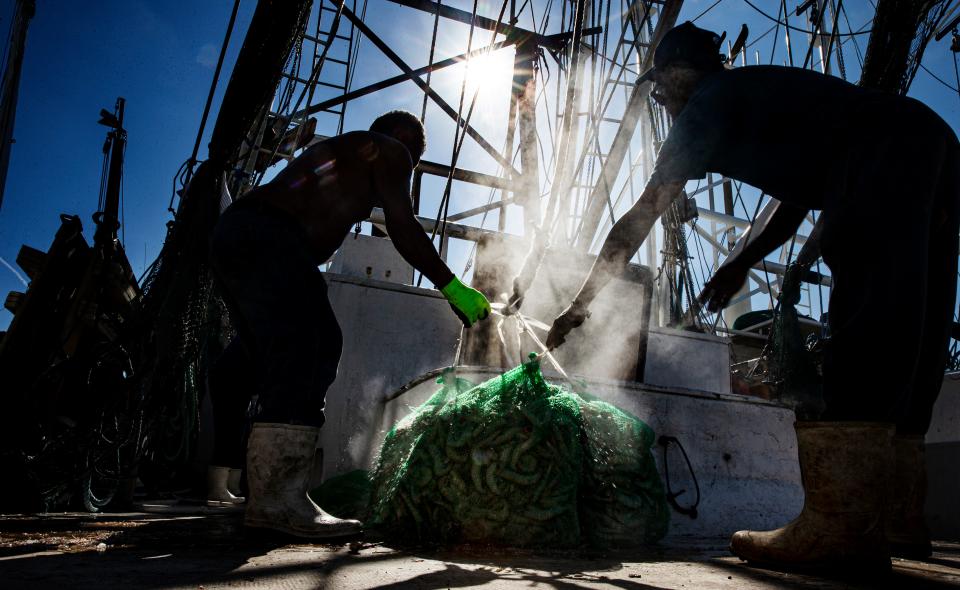
‘The most beautiful shrimp they had ever beheld’
The story of these shrimp begins in 1949 with a fish tale that turned out to be true. As the lore goes, shrimp operators heard from shark fishermen working the Dry Tortugas off Key West that they had caught sharks stuffed with jumbo shrimp in their bellies. The men undertook a secret exploratory trawling expedition.
After striking out all day, they cast a net at dark.
The result was poetry, as described in The Saturday Evening Post in 1950.
“What made them try one more drag after nightfall isn’t clear, but at any rate, when they hauled it up out of the blackness, it was heavy with giant shrimp – the most beautiful shrimp they had ever beheld, gorgeous creatures of an unusual pink gold hue.”
Pink shrimp travel by night.
The grapevine was strong. Within months, pink shrimp became the darlings of the fisheries, luring the “the greatest shrimp flotilla ever assembled in American waters,” according to newspapers. Fort Myers Beach emerged as a critical port to unload “pink gold.”
By spring 1950, docks, a fish house and packing plants began rising along Matanzas Pass. On the San Carlos Island side, streets crowded with buyers and refrigerated semi-trucks waiting to carry shrimp north.
It was shrimp that lured Carl and Babe Erickson, Anna’s great-grandparents, to Fort Myers around the same time. They arrived from Montauk, Long Island on a wooden fishing boat, The Malolo, the forebearer to the only boat that could shrimp after Ian.
The industry that grew up around the beach to accommodate the pink gold rush is credited with doubling the population and spurring a development boom. By the early 1960s, more than 250 trawlers were based at Fort Myers Beach.
But after the rush came the fall. By 1975, with rising fuel costs and a poor market for shrimp, “the profession is becoming one of the world’s great gambles,” said a News-Press article.
Local headlines drummed a death knell each decade.
80s. Shrimpers suffer through bad season. 90s. Local industry battered by competition, high costs. 2000s. Shrimpers Struggle to Stay Afloat.
Each passing year seemed to bring a new cloud of defeat, as low shrimp prices and high fuel costs converged.
“The Gulf fleet has shrunk substantially over the last few decades due to intense competition from imported farm-raised shrimp which has led to lower shrimp prices and lower profitability for Gulf shrimpers,” said Andrew Ropicki, Florida Sea Grant’s marine economist and an assistant professor at the University of Florida.
Yet for all the industry's suffering, it remained a mighty economic force.
“It’s an important thread of the whole community,” said Joanne Semmer, president of the Ostego Bay Foundation and a Fort Myers Beach historian. “There are people trying to say the shrimping industry is dying but they’re mostly developers.”
Lee County, namely Fort Myers Beach, is home to the biggest pink shrimp port in Florida. In 2021, the fleet landed 4 million pounds of shrimp, valued at nearly $13 million, according to state data. Lee represented about half of the state’s overall pink shrimp landings.
The fleet was a fraction of its former self, but still 40 boats strong. Then came Ian.
By the time the crosshairs of hurricane models shifted from Tampa Bay to Fort Myers Beach, boat owners felt it was too late to flee. Despite pleas from loved ones, captains and crew rode out the storm where many feel most at home: the boats.
The Storm
Hurricane Ian made landfall Sept. 28 as a devastating Category 4+ monster, 20 miles northwest of the Fort Myers Beach fleet. That put the fleet in a position to bear the brunt of the storm's fury.
Anna Erickson hunkered down at her Fort Myers home, about 15 miles north. She was most worried about her shrimp family, the people who stayed. At one point, she couldn’t reach anyone and thought the worst. Oh my God, people are dying.
Captains and crew were fighting for the boats – and their lives.
Water raced into Matanzas Pass so swiftly that veterans of the sea felt like they were in a scene from a horror movie. Rough seas come with commercial fishing, but 18 feet of storm surge was next level. The wind blew in like a freight train.
Cars, rooftops, trees swept into the pass. Yachts and sailboats spun as if they were toy boats in a bathtub. The sound of all that metal scraping was haunting.
Thick lines they used to tie the boats to each other for stability snapped like thread. The rain of saltwater and sands cut the skin as the men braved the storm to retie lines and save their boats.
Logan Lyons, the Malolo’s captain, described the battles that endured from the day to night like “fighting a thousand people.”
Shrimp boats clanked and creaked as the hurricane transformed them to massive bumper boats, shoving each other into trees, lots and docks and a mobile home park before the water began to recede. Although captains set the boats in reverse as the surge rolled out, the horsepower was no match for the strength of Mother Nature who left them stranded on land.
First mate Kenny Washington, 62, watched the weather from the wheelhouse of Perseverance when he felt the boat bump, bump, bump into pilings.
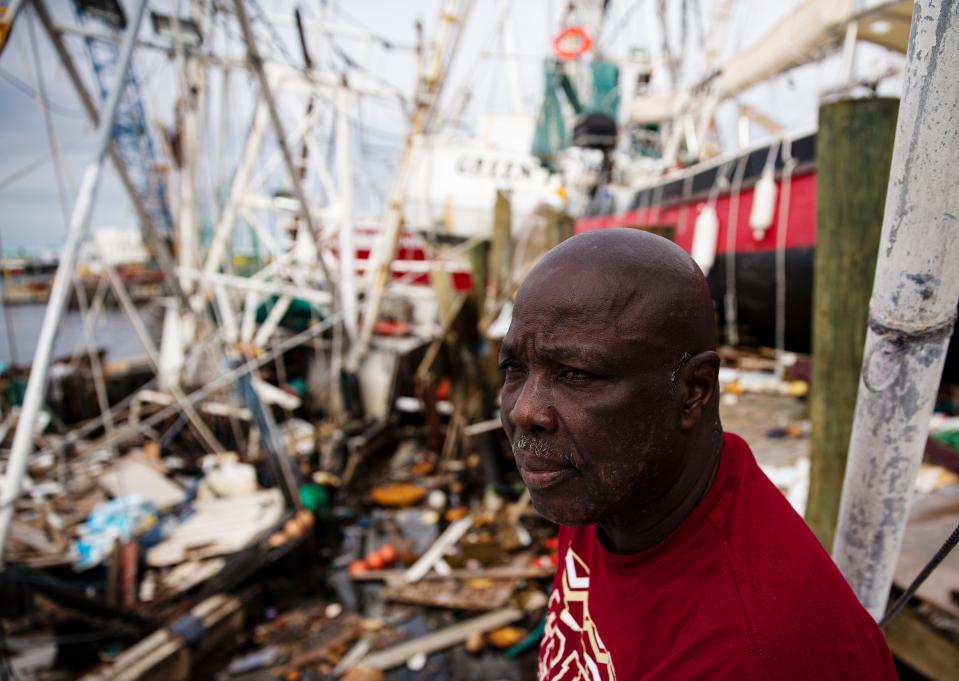
Water flooded the engine room. He called to two other guys onboard. “TIME TO GO!”
Now came the fear, and the danger was even greater for Kenny. He’s never taken to swimming though he’s made his living off the water for nearly 40 years.
He saw that another boat, the Green Flash, was close enough to grab. He reached up for the rail and held tight. He pulled himself up, found a foothold and flung himself over. He watched The Perseverance sink to its wheelhouse.
He felt lucky to be alive, especially when he spotted a hand bobbing in the pass. That was a life, he thought. That was somebody’s loved one who was now missing. He felt empty in his powerlessness to help.
He heard the helicopters searching for survivors. By then, it was daylight.
He looked around the docks, where shrimpers gathered, cursing and smoking, while others slipped in the muck as they assessed the fleet.
What a mess we got here.
Nearly all the boats were grounded.
The biggest boat in the Erickson fleet, the Double E tipped on its side. The captain called out. “Hey Kenny!”
“What's the matter?” Kenny hollered back.
He needed his help getting the kids off the boat. The captain had stayed on the Double E with his wife and their five kids. There was a gap between an aluminum ladder propped up against the boat and the land. Could Kenny catch them?
At 6-foot-4 Kenny was tall enough to straddle the space between water and land. At 265 pounds, he was solid enough to catch flying kids. He held the ladder in place. “Toss ‘em here.”
The 3-year-old triplets came first.
The little girl landed in his arms. He set her to the side. “Stand right there.”
Then came her brother, “Hold onto your sister.”
And the second brother. “Hold onto each other.”
The 6-year-old girl came next. He coached the 10-year-old boy down. “I ain't goin’ let you fall.”
He hugged the tearful kids as the captain and his wife descended. “Here’s your Mommy and Daddy. The worst is already over with.”
That didn’t feel true for many though. While the word at the docks was that no shrimpers had died, it felt like the fleet had.
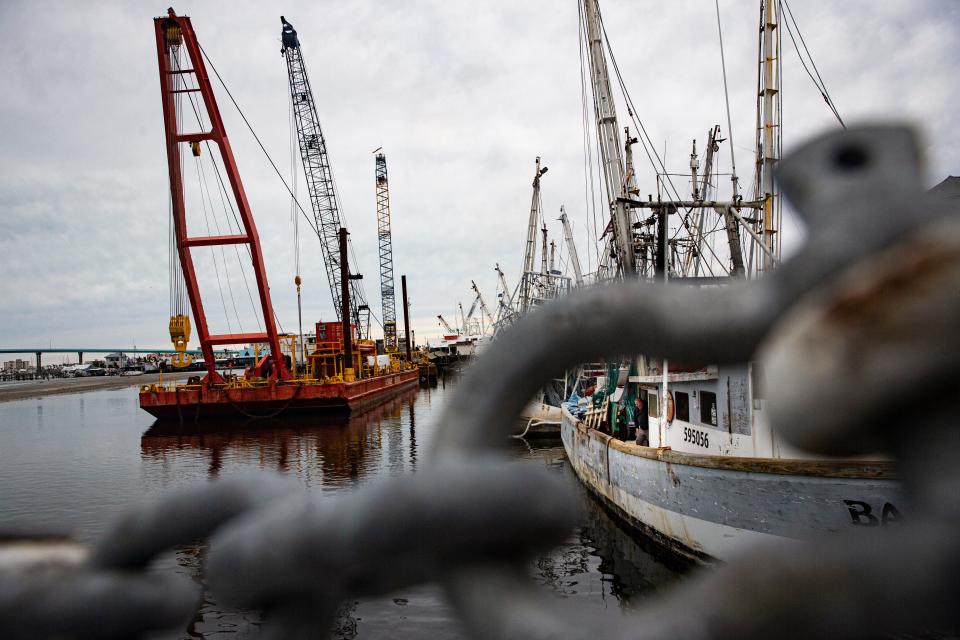
The Crossroads
A day or two after the storm, Anna Erickson went to her parent’s house for dinner. While her mom Susan was cooking, her father Grant Erickson suggested they go for a stroll.
Ian forced the family business to a crossroads. At 69, Grant had fewer years left in the industry than she did. Did she still want the business in this condition? With only one boat of their 11 boats able to go out shrimping?
They had five acres of valuable waterfront property. They could get what they get for the boats.
“If we sell it all, we would be fine for the rest of our lives. What do you want to do?”
Anna didn’t hesitate.
“We’ve got to stick with this. We’ve got too many people here that rely on us. This is all I know. This is all I want to know.”
Around the same time, Christine Gala, an owner of the Trico Shrimp Company, was facing similar questions.
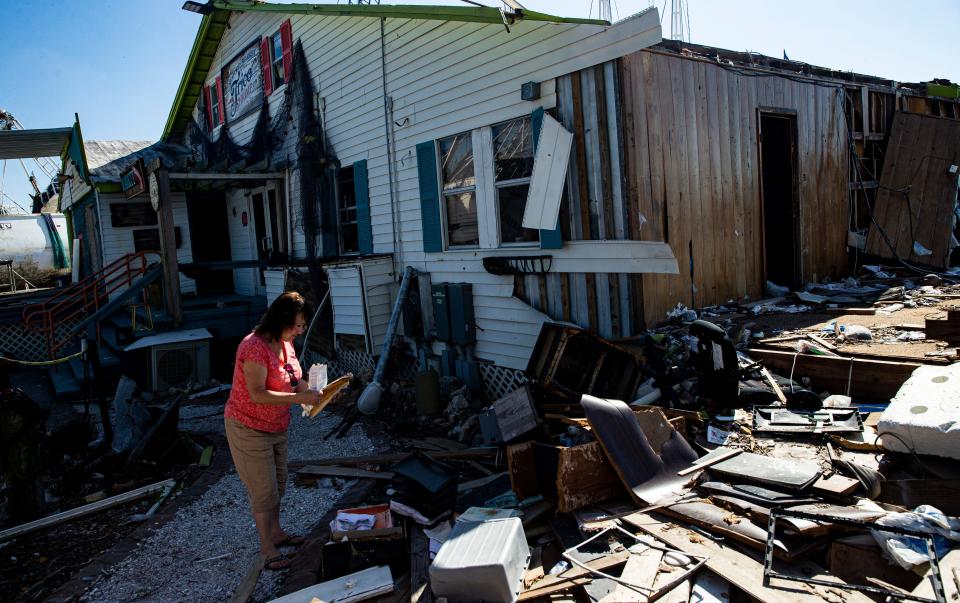
She had seen the business through 45 years but now none of their dozen boats were in the water. Neither were the dozen more that unload shrimp with the company. Their docks were decimated. The market had flooded. The seafood in the freezer was rotting. Her office was rubble. Do we just give up?
But she didn’t stay in that space for long. “We’re going to get it all back together and go shrimpin'.”
At least the industry had some powerful allies.
A week after the storm, in early October, President Joe Biden and Gov. Ron DeSantis gave a press conference blocks from the shrimp docks.
Tracey Gore was there representing the fishing industry.
The former Fort Myers Beach mayor owns Gore Seafood Inc. with her husband, shrimper Henry Gore. They have one of the fleet’s few independent boats, the Lexi Joe, named after their two grown children. The Lexi Joe was grounded too. Though they were among the few in the fleet with insurance, she couldn’t imagine a policy that would pay for the kind of equipment needed to put it back in the water.
That day, the governor told her, We’re going to get the boats back in the water.
The president told her, We’re going to help you.
She teared up at the prospect of two political foes joining forces.
But could they make good on their promises?
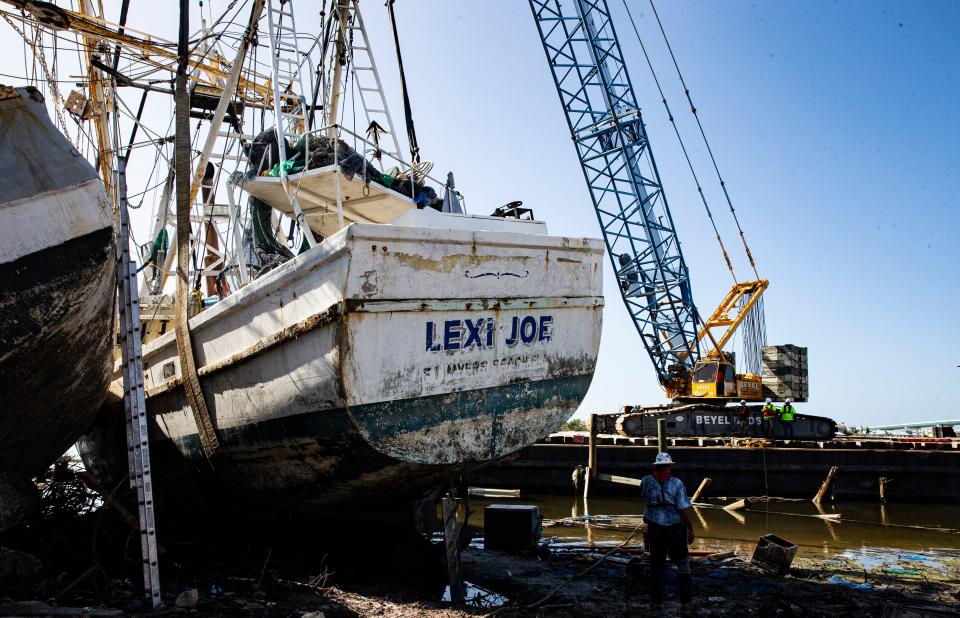
Florida Division of Emergency Management did not provide details on the cost of the recovery operations and contract rates were blacked out in public records requested. But a representative with the Beyel Brothers crane and rigging company said they brought about $10 million worth of equipment and a dozen workers. The state contracted with them to lift two more boats after they hoisted the Double E.
Lexi Joe was one of them. In November, Tracey and Henry Gore watched the multi-day operation as the crane tugged and picked at their 76-foot fiberglass livelihood.
Tracey turned to Henry, “Oh my God, I’m scared they're going to punch a hole in the back.”
The boat looked close to the water but was suctioned to the ground.
Henry couldn’t take it anymore. He decided: One way or another, get the Lexi Joe in the water. They needed to move forward with their lives.
The crane finally hoisted the Lexi Joe into the water and Henry captained it to an Alabama shipyard for repairs. For Tracey, it was a huge relief but bittersweet.
“We’re not an industry with two or three boats,” she said later. “You need all 40 boats to be an industry. They spend their lives together. They have to depend on each other.”
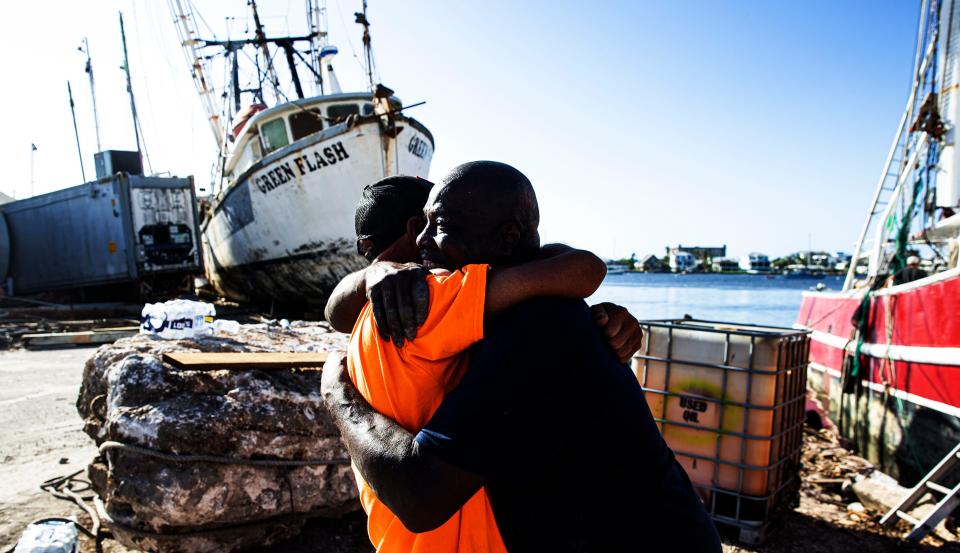
The Malolo Returns
The nearly 80-foot fiberglass Erickson trawler rolled into port at daybreak on a November morning. It was returning from the shrimping grounds of the Dry Tortugas, where pink shrimp were discovered. The boat spent 24 nights out fishing.
It was the only boat in the entire fleet to return with shrimp since Ian.
How did the Malolo get so lucky? Did the name conjure up some Erickson family magic? Certainly, it helped to have a seasoned captain. Before the storm, Logan Lyons positioned the Malolo between two other boats for protection from stray boats and the docks. The wiry 65-year-old has been a captain since age 21.
On the trip, he saw an abundance of small shrimp, but the crew, which included Perseverance survivor Kenny Washington, picked out the smaller shrimp because Logan didn’t want to come back with a “boat full of nothing.” They kept shrimp big enough to average out to about $2 a pound at a size that in the past would have brought about $3.50.
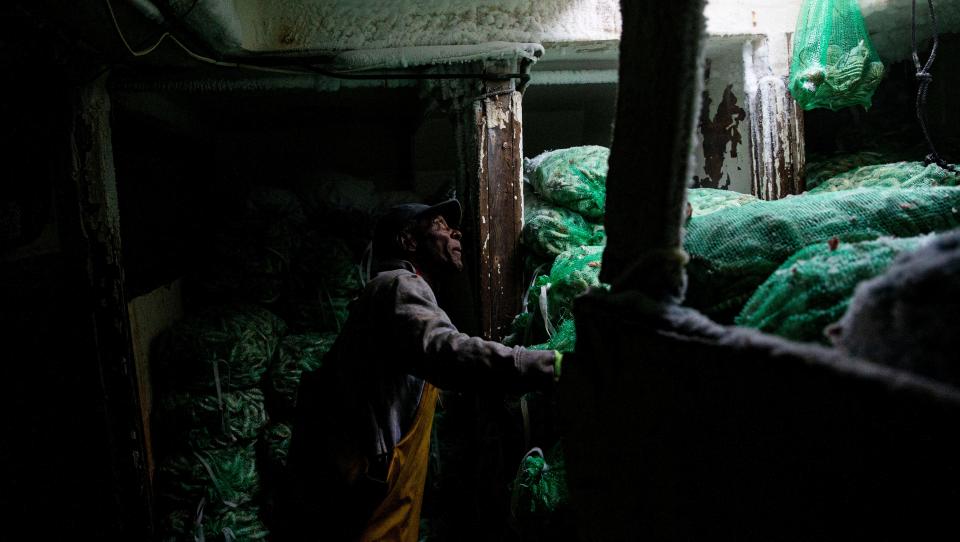
They flash froze the shrimp in a brine tank before stowing them in the below deck freezer. A major selling point is they arrive at the docks preservative free. Another selling point: pink shrimp are sustainable. The Gulf of Mexico stock is not overfished.
Once the Malolo was tied up at San Carlos Island, Logan tugged on insulated coveralls and descended into the ice hole of the Malolo, which he keeps between five and negative five degrees, so the shrimp stay juicy.
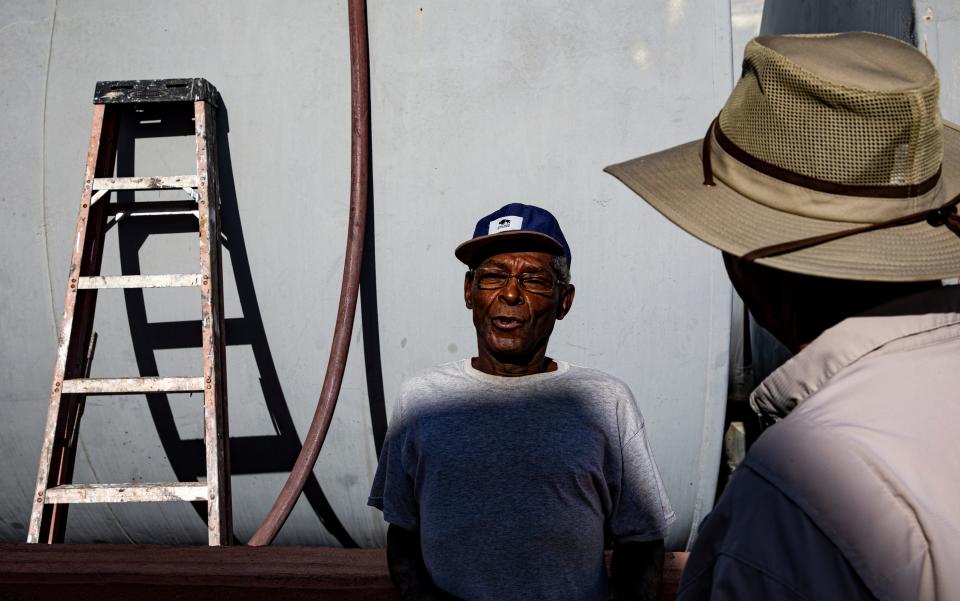
Amid the stacked bags of jumbo shrimp, he imagined there was about $60,000 to $70,000 here. Before the storm, Erickson & Jensen was unloading about 20 times more worth of shrimp each month. Now they were down to only the Malolo’s catch.
Logan felt blessed the boat could go out. He would have felt more blessed if the shrimp prices were better. He had a new house and was running behind on bills. “I’m in a pickle here. I can’t pay nobody until I get the shrimp off the boat, and they give me my check,” he said.
As captain, Logan earned about $9,000 for his 15-ton catch. Certainly not bad for a month of work, yet he sees no future in shrimping and would never allow his three grandsons to follow him into it. “Those boys are going to college.”
With the fresh shrimp came loyal customers, who buy the delicacies for themselves, sell it at markets and restaurants and use it for shrimp dinners.
“Hey, y’all,” said Anna Erickson, greeting early arrivals at the fish house in a leopard-print rain jacket with her long brown hair pulled into a topknot.
Gary Kolmonen, 71, a Key West native who prided himself on knowing good shrimp, was the first there. “This is the tastiest shrimp in the world. No match for it.”
Even the stray cat he feeds shrimp every day can tell the difference. If he brings her out something other than fresh Gulf shrimp, she sniffs and walks away. “An animal knows. They can smell chemicals.”
Anna tested the wooden plank over the smashed docks that connected the fish house, which had been speared by a sailboat, to the Malolo. The plank wobbled as she fetched a heavy bag of shrimp from the boat for Gary. “I save the best for locals,” she said, with a smile.
It felt good to be selling despite the catastrophic surroundings.
“Every little step is a step for us,” Anna said between customers. “It's bringing people to a point where they're like, everything will be okay.”
At that point, Erickson & Jensen had four boats floating. Still, only two were able to fish. The Babe, which was named for her great-grandmother, had just gone out. And the Anna, a trawler named for her, was expected to head out soon.
Closer to neighboring Trico Shrimp, Blaine Green, 66, patched holes on the 70-foot trawler Aces & Eights. His hands were calloused. After shrimping for a half-century, it was hard for Blaine to feel optimistic about the future of the fleet amid the wreckage. “This right here may take the shrimp fleet out of Fort Myers. We may not ever recover.”
It could all disappear. “Just like Blockbuster.”
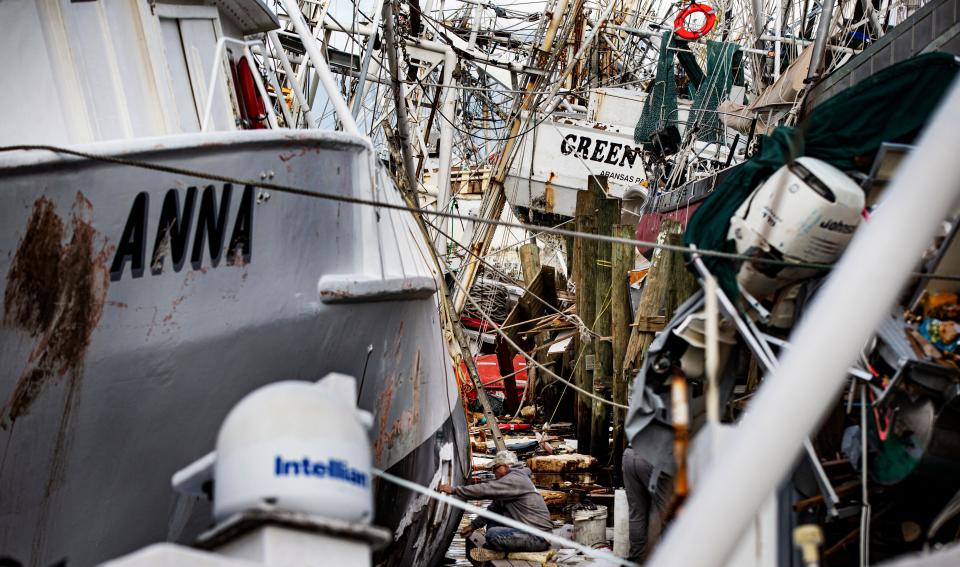
Aces & Eights
Blaine Green had made just one payment on his boat when Hurricane Ian became a worst-case scenario for Fort Myers Beach.
He bought the boat used for about $150,000. It was his sixth shrimp boat. He knew it would probably be the last, so he named it Aces & Eights, a name he had always loved even though his wife worried it could bring bad luck because it was the dead man’s hand in poker. So the story goes, frontier hero Wild Bill Hickok held aces and eights when he was shot in 1876.
Blaine named his first trawler, The Illusion. Straight out of high school, he bought the boat with his late father, Dave Green, a local fishing legend who was said to the be first male born on Fort Myers Beach.
“When the rich people came down here, the Fords and the Edisons and all them, my dad and his brothers would take them all tarpon fishing,” said Blaine. According to a newspaper article, his father even pulled aviator Charles Lindbergh’s sailboat off an Estero Bay sandbar.
To Blaine it felt natural to work on the water. His parents raised him and his five siblings on San Carlos Island. “We didn't know anything different.”
And shrimping was far more lucrative back then. “We were the rich kids in high school.”

Blaine rode out Ian on Aces & Eights, which fared well until other shrimp boats started breaking loose and charging toward the boat, shoving it ashore and onto pilings. She landed in a construction yard adjacent to Trico Shrimp.
After the storm, he got help propping up his boat so that he could start patching the five holes. The biggest was on the bottom and ended up being 12 by 8 feet. He spent thousands. “If I did it at a boatyard, the boat would have been a total loss. Nobody would ever fix that boat except for me. I had no choice. I had no insurance and no livelihood other than that.”
The hurricane had doused the inside of his boat with saltwater as the wind forced water through doors and vents. His engines were rusting. He worried about the equipment on his boat freezing up and drying out the longer it sat it on land. The wait was painful and expensive.
So he was thrilled when he got word in late November: Get your boat ready.
The crane would try to rescue her.
Over the next few days, he hustled like mad and even managed to give Aces & Eights a new paint job for the occasion. She was handsome in crisp black and white. Blaine barely slept the night before the floating barge with the crane showed up near his boat. It was her shot at floating and his chance to reclaim some normalcy.
But Aces & Eights was not young. Would she survive this kind of lift? And yet she was so close, cruelly close to the seawall − mere feet from Matanzas Pass, mere feet from a shrimping trip. They rigged up the hoisting equipment. The crane hooked to the boat and tugged. The jackstands beneath Aces & Eights came loose.
But after several minutes everything came to a halt.
Nope, the crane couldn’t pick it up, someone told Blaine.
What!? That didn’t make sense to Blaine. To him, it looked like they barely tried. To him, it looked like a perfectly capable crane. And he knew cranes. Along with fishing, Green was a crane operator for 20 years.
If they couldn’t pick up his boat, which at about 80 tons was one of smallest boats there, they needed to pack up and go home, he thought.
Weeks later, on a December morning, Blaine scanned the harbor. “A lot of these boats should have been back in the water a long time ago. I don't know what they're dragging ass on," he said. "I'm sitting here now ready to go in the water and I'm waiting on another crane to show up."
All he wanted to do was go out shrimping even if it meant skipping Christmas, New Year’s.
Blaine was not the only one getting frustrated with the glacial pace of recovery. The adrenaline that had lingered around the docks for shrimpers who had survived the storm had dissipated. Hope for a full fleet comeback was dimming. People were getting scared. They were running low on money, behind on bills. Maybe they would never get their jobs back? The Red Cross was no longer showing up daily with hot meals. They needed help soon or their fears would come true: the industry would die.
Over at Erickson, fleet manager Jesse Clapham fixed fuel storage tanks knocked out of place by the surge. He always seemed to be working. His back hurt. His eyes were tired, his hands dirty. Nearly three months since the hurricane and the situation didn’t look all that much different for the fleet.
“If I had a million dollars I would sit down and figure out how to rent a couple bulldozers and equipment and I could get these boats back in the water with me and probably two guys,” Jesse said. “It would be better than all this horseshit that's going on now.”
The first crane company had only hauled up three boats, including the Double E and the Lexi Joe, in two months.
At Trico Shrimp, Blaine spotted owner Christine Gala and strolled over.
“Are those Hey Dudes?” Christine called out.
A booty of new boat shoes had washed up in Ian, an unexpected gift from the sea.
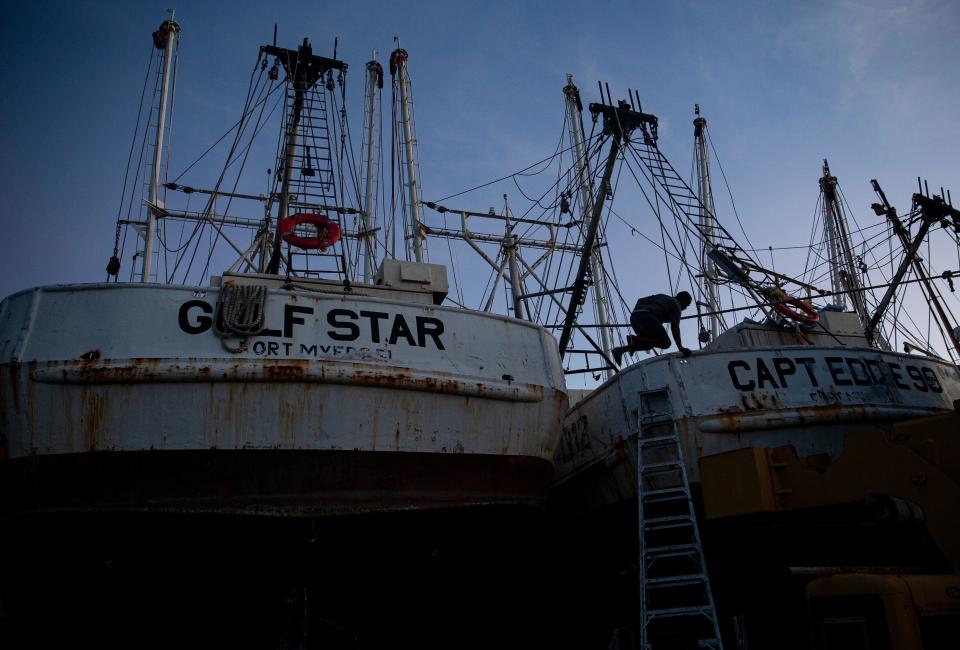
Blaine nodded. “I got about 200 pair over there. I swear we picked up 500 or 600, maybe 1,000 shoes, and my daughter-in-law, her and the kids just sat there and matched them up.”
He smiled. “I've been throwing them away when they get dirty.”
They both laughed. It was hard to find things to laugh about on the waterfront. There were still no Trico Shrimp boats back in the water. But Blaine and Christine found other positives, like how nice it was not to smell the rotting seafood in the air. The wind was blowing a different way that morning.
Finally, there was some good news. There was a new strategy, a new company that pledged to recover the rest of the fleet: Resolve Marine, a Fort Lauderdale-based company specializing in marine salvage.
“Resolve is the one that has the equipment we need,” said Christine, adding that she'd been told that a bigger barge was needed for a stronger lift.
A plan sent to Lee County said Resolve had received a purchase order from the Florida Division of Emergency Management for the recovery of stranded trawlers. It was unclear if the first and second companies would be working together. The plan listed 39 shrimp boats and what was required to move boats into the water. They would deploy various means, including roller bags, a heavy-lifting barge and divers. The operation was estimated to take 54 days and the lifting of the boats was expected to start a few days before the new year.
Finally, maybe that much-needed miracle was on the horizon for the rest of the fleet?
Christine Gala was cautiously positive. “Now, hopefully with the bigger cranes, more cranes, more barges and the roller bags, they tell us that's real important, then we'll be able to get these boats in the water.”
Meanwhile, the Babe, the second boat from the Erickson fleet to go after Ian, had just returned from shrimping.
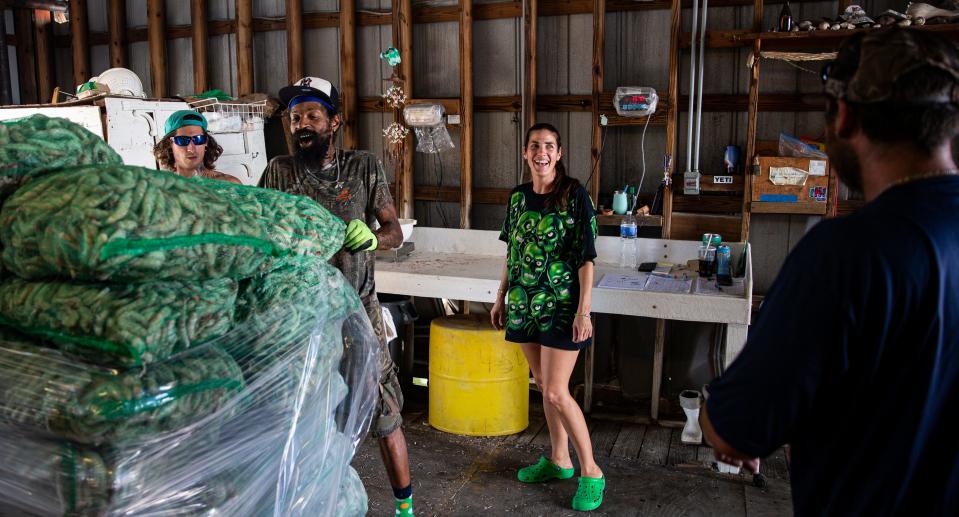
A chance to rebloom?
Anna Erickson power-walked along the waterfront path between Erickson & Jensen and Trico Shrimp. She was on a mission to recruit help to unload the Babe.
These days, it was hard finding workers. They had gone from a labor force of hundreds to dozens. It was December and crew members were long gone, departing for other ports and other places once it became clear the industry was not bouncing back swiftly. Yet Erickson & Jensen had fresh shrimp to be packed. A refrigerated semi-truck was waiting near the fish house to take their shrimp to a seafood processor.
Along the way, Anna passed the bougainvillea her grandfather planted and a mango tree maybe as old as her that had fed the people who worked the waterfront. She lamented their sorry condition. Their leaves and branches had been soaked in saltwater.
She had been thinking about the future. Some boats may not ever make it back on the water. But beyond getting those out that could, she saw lots to be done. One step would be constructing a 2,000-foot bulkhead and giant pilings so the boats could go up and down instead of floating over the docks and onto land as they did. Because another storm was inevitable.
Anna approached three men sipping beer, not an uncommon morning beverage here, near the tents where they’d been sleeping since the storm. “Want to work today, I really need ya?” There was one taker. She went in search of more. Across the lot, Anna spotted a middle-aged guy in jean shorts. “HEY! Can you work?”
“What do you want me for?” he said.
“Just pulling bags on the pallet.”
He fell in with her swift pace.
“OK, is that a yes?” she asked, with a smile.
“Am I followin’ ya?”
She slung an arm around him and introduced him to this reporter. “This is Drunk Sean.”
He earned his nickname for obvious reasons. Around the docks, there are other doozies: Scumbum, Chicken, Triple T, Johnny Rotten and Nipples, a 58-year-old crew member with a dolphin tattoo also known as Michele Bryant who says it’s too hot to wear a bra.
Michele calls Anna, Anna Banana, but also Boss Lady. Anna is the head of shrimp sales and has been unloading boats for about a decade, a job she learned by trial, error and passion.
As Anna and Sean walked to the fish house, they heard a common refrain, “Hey Anna!”
It was Kathy Hart, 61, who spent three decades shrimping and considered the people at the docks her family, a term others use too, though sometimes it’s also preceded by the adjective dysfunctional. Grit is required to belong.
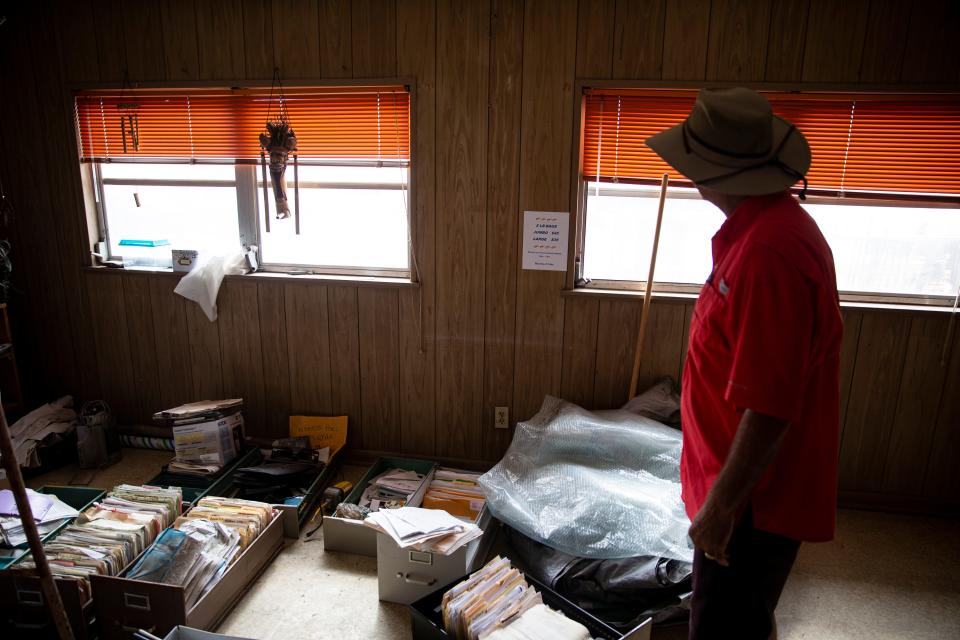
Kathy was cleaning out the office, which had been inundated during Ian. She dangled a piece of paper. “We’ve got to let this dry. It’s your daddy’s.”
The paper was Grant Erickson’s University of Florida diploma.
Anna assessed the black mold. “I think it’s done-zo.”
Kathy pledged to try. Also on Kathy’s morning agenda: to replant the seedlings left by the suffering mango tree.
Back at the fish house, Anna cleared the long table, where she would get sample weights for each pallet. She dropped a stray frozen shrimp through the cracks in the wooden planks. “Good morning snook! Wakey-wakey.”
She stepped out to the Babe. “How’s the deck crew, everybody in a good way?”
They nodded. Andrew Shroyer wore a ski mask in preparation for his job hooking shrimp bags in the below deck freezer. His mom had shrimped for Erickson too. Triple T, a poet in his spare time, was ready to help above deck. He was 72 but still spry and showed off his abs as proof.
The fish house crew included Gino Simmons, 42, who said he was too bougie to go out shrimping but considered himself part of a dream team of unloaders and took pride in making Anna happy. Between the boat and the fish house, there were seven strong men and Nipples, who was assigned to paperwork.
The conveyer belt switched on. A portable speaker pumped Alice in Chains.
A rope hoisted a bag of shrimp from the freezer like a magic trick. The enormous pink wonders emerged, encircled in wisps of steam as they hit the hot air. The deck crew placed the bags on the belt, which the fish house crew pulled off and stacked on a wooden pallet until it reached nearly 2,000 pounds of shrimp. Then they grabbed plastic and twirled around the tower of crustaceans, swaddling it in plastic, before Alex Bean, a pragmatic on-task 32-year-old, arrived with a jack to cart the shrimp to the truck.
Anna gave the pallet a good heave. “Bye shrimp!”
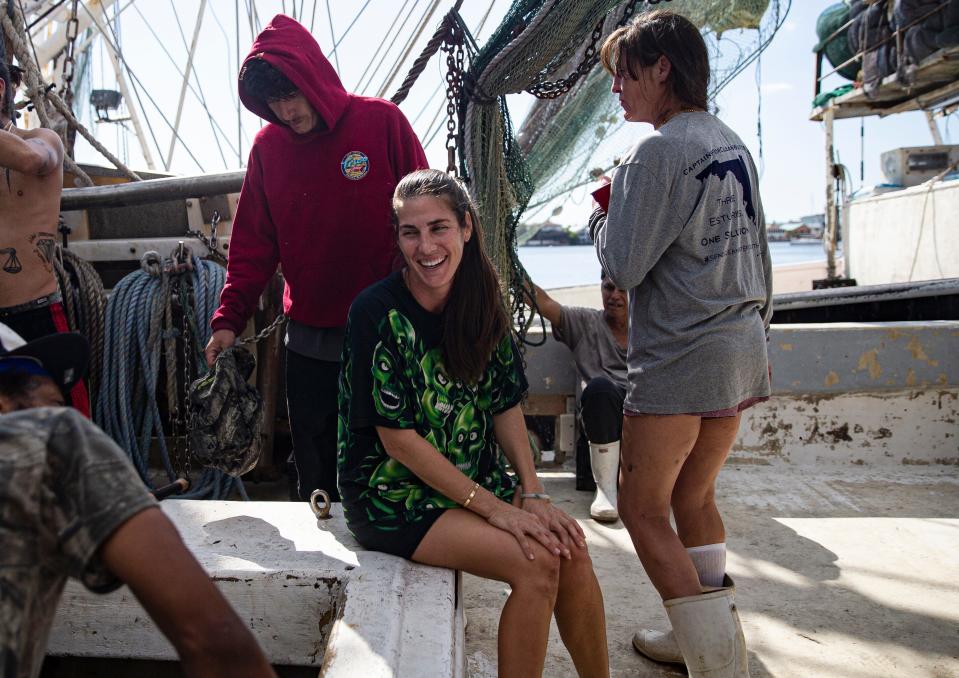
The crew set down another pallet, more cardboard, more shrimp, again and again. Anna oversaw the hours-long process of unloading the boat, chipping in wherever needed, weighing and checking the quality of the shrimp and cheerfully shouting, “Ándale! Ándale!” amid distractions, interruptions, teasing and singing.
At one point, Sparky, a toy chihuahua sauntered through and brought progress to a standstill. At another, Drunk Sean returned without shoes. A crew member disappeared to check the beans on his stove and reappeared with a plate to share. Johnny Rotten rolled through on a bike. There was McDonald’s to eat and cigarettes to be lit, but the men are skilled at working and smoking.
In the afternoon, Kathy Hart showed up with a report on the foliage planted by Anna’s grandfather. “She’s starting to bloom a little up there, the bougainvillea.”
Anna sighed with hope. “I’m really praying that’s coming back.”
Kathy held out two large pots with fresh soil and the mango seedlings from the tree. Anna admired her work. “Thank you. I love you, Kathy!”
“I love you too,” said Kathy.
Maybe they were just mango seedlings, but the fact that Anna was trying to revive the business down to a lost mango tree felt symbolic. She cared about the mango tree, but she cared even more about her roots, her industry.
They placed the pots near the waterfront, hoping someday both would bloom.
 
10940548002
View Live Edit video
- Video
- Andrew West
- Fort Myers News Press
- news/local
- 12/27/22 1:09:21 PM
- Not embargoed
- Metered Content
video:
Return to Asset Tab
Fort Myers Beach shrimp docks before Hurricane Ian, a look at the industry before a Category 4 storm pummeled Southwest Florida and the fleet
Andrew West - Fort Myers News-Press
SEO Warning
Layout Priority
This article originally appeared on USA TODAY: Fort Myers Beach shrimping industry struggling to recover after Ian

